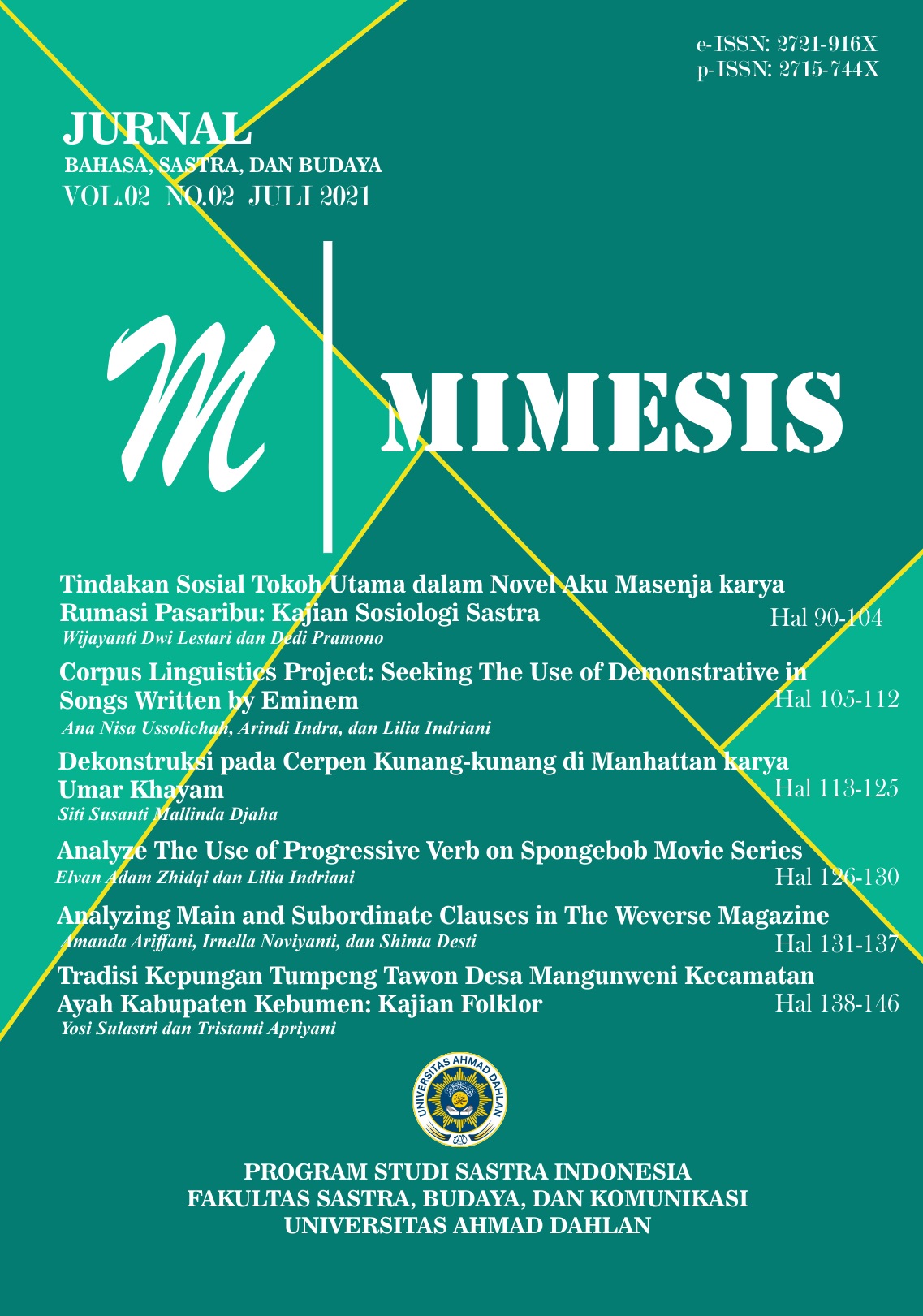DEKONSTRUKSI PADA CERPEN SERIBU KUNANG-KUNANG DI MANHATTAN KARYA UMAR KAYAM
DOI:
https://doi.org/10.12928/mms.v2i2.4226Keywords:
Deconstruction, short story, Seribu Kunang-Kunang di Manhattan, Umar KayamAbstract
This study aims at analyzing the deconstruction process in the short story Seribu Kunang-Kunang di Manhattanby Umar Kayam by looking at the binary oppositions as well as the form of deconstruction that happens in the short story. The theory used in this study is deconstruction theory by Jacques Derrida. The result showed that there were several binary oppositions, namely: West and East, big city and village, man and woman. The oppositions described in this story are problematic. The first opposition, West and East, was reversed and won by the East. The second opposition, the city and the village, experienced a reversal so that the village won. Likewise, with the third opposition, man and woman also experienced a reversal and won by the woman. In the end, this research shows that these hierarchical oppositions do not exist and are only the result of the construction of the author's imagination. Yet the author rejects what he wants to portray in the story, the Western life in Manhattan, United States.
References
Eagleton, T. (1983). Literary theory. Oxford: Basil Blackwell.
Faruk. (2012). Metode penelitian sastra: sebuah penjelajahan awal. Yogyakarta: Pustaka Pelajar.
Kayam, U. (2003). Seribu kunang-kunang di Manhattan. Jakarta: PT. Pustaka Utama Grafitti.
Pujiharto. (2001). Analisis dekonstruksi cerpen rembulan terapung di kolam renang. Prosiding Pertemuan Ilmiah Bahasa dan Sastra Indonesia XXIII, 9-10 Oktober 2001. Yogyakarta: Universitas Ahmad Dahlan.
Sarup, M. (1993). An introductory guide to postructuralisme and postmodernism. New York: Â Harvester Wheatsheaf.
Sarup, M. (2008). Panduan pengantar untuk memahami postrukturalisme dan posmodernisme. Yogyakarta: Jalasutra.
Soleh, R. (2004). Profil “orang-orang pinggiran amerika†dalam cerpen-cerpen Umar Kayam. https://doi.org/10.22146/jh.1305
Teew, A. (1988). Sastra dan ilmu sastra. Jakarta: Pustaka Jaya-Girimukti Pasaka.
Wikipedia.org. (Januari 2013). Manhattan. <http://en.wikipedia.org/wiki/Manhattan>
Young, R (ed.). (1987). Untying the text: a post-structuralist reader. London dan New York: Routledge & Kegan Paul.
Zulfadhli. (2009). dekonstruksi dalam cerpen malin kundang, ibunya durhaka karya A.A. Navis. https://doi.org/10.24036/komposisi.v10i2.62
Downloads
Published
Issue
Section
License
Copyright (c) 2021 Siti Susanti Mallida Djaha

This work is licensed under a Creative Commons Attribution-ShareAlike 4.0 International License.
License and Copyright Agreement
In submitting the manuscript to the journal, the authors certify that:
- They are authorized by their co-authors to enter into these arrangements.
- The work described has not been formally published before, except in the form of an abstract or as part of a published lecture, review, thesis, or overlay journal.
- That it is not under consideration for publication elsewhere,
- That its publication has been approved by all the author(s) and by the responsible authorities tacitly or explicitly of the institutes where the work has been carried out.
- They secure the right to reproduce any material that has already been published or copyrighted elsewhere.
- They agree to the following license and copyright agreement.
Copyright
Authors who publish with Mimesis agree to the following terms:
- Authors retain copyright and grant the journal right of first publication with the work simultaneously licensed under a Creative Commons Attribution License (CC BY-SA 4.0) that allows others to share the work with an acknowledgment of the work's authorship and initial publication in this journal.
- Authors are able to enter into separate, additional contractual arrangements for the non-exclusive distribution of the journal's published version of the work (e.g., post it to an institutional repository or publish it in a book), with an acknowledgment of its initial publication in this journal.
- Authors are permitted and encouraged to post their work online (e.g., in institutional repositories or on their website) prior to and during the submission process, as it can lead to productive exchanges, as well as earlier and greater citation of published work.











